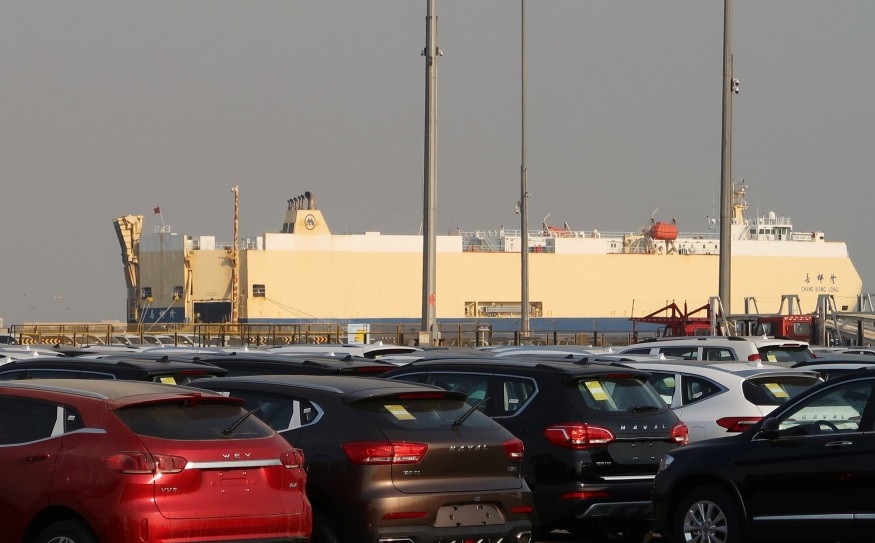[Analytics] Chinese traders in American cars find temporary relief in trade war truce

Cars at China’s Tianjin port, where traders are scrambling to take advantage of the 90-day truce in the trade war. Photo: Reuters Reuters
TIANJIN, Jan 10, 2019, Reuters. In the northeastern Chinese port city of Tianjin, grey market traders of American-made cars, badly stung by the US-China trade war and punitive tit-for-tat tariffs, are scrambling to take advantage of an opportunity they fear may prove only temporary, reported the South China Morning Post.
At a car “supermarket” near the city’s busy harbour, importers said they were rushing to get “Made in America” cars through customs and revving up orders after Beijing temporarily cut tariffs on US cars from January 1.
The grey market trade in Tianjin is only a part of China’s car market, the world’s largest, but it gives an important insight into the imported car trade.
While carmakers prefer importing their own vehicles, Beijing has been encouraging alternative channels, fuelling a growth in the grey market.
This grey market channel made up roughly 14 per cent of all imported cars in China in 2017, almost double the 7.7 per cent in 2014, according to data from China’s biggest car importer, Sinomach Automobile Co Ltd.
Tianjin is the biggest port in China in terms of parallel car imports, bringing in around 70 per cent of the country’s overall parallel car imports, according to a commerce ministry report.
Dealers estimate there are more than 10,000 US-made cars sitting in the port’s bonded zones.
With no guarantee the lower tariff window would not close again at the end of March, firms were rushing to bring cars in, dealers and industry insiders said.
The activity at the port – after a freeze since China hit US car imports with a 40 per cent tariff last July – illustrates how ebbs and flows in the protracted trade war between Washington and Beijing are impacting global businesses.
“Our business was harshly hit in 2018. Sales fell steeply and we were forced to hold cars in bonded zones to wait for tariffs to be cut,” said Kevin Li, a dealer at the port whose firm brings in US-made luxury SUVs.
“Now we are discussing with dealers in the US to start importing more cars once again.”
The higher tariffs have hit premium carmakers which manufacture in the US and export a large proportion of the vehicles they sell to China, including Tesla, Ford’s Lincoln brand, and Germany’s BMW and Daimler, which both have manufacturing facilities in the United States.
Chinese and US trade negotiators have been locked in talks in Beijing this week in a bid to end the trade tensions that have rocked markets. Those talks wrapped up on Wednesday, with hopes growing that a deal could be struck.
The two countries’ leaders declared a 90-day trade truce last month after talks on the sidelines of the G20 meeting in Argentina, which saw China’s steep levies on cars trimmed back for a three-month period until the end of March.
In the first 10 months of 2018, US passenger vehicle exports to China, excluding those for public transport, were just under US$6 billion, down from more than $8.5 billion in the same period the year before.
Since the middle of last year, when China raised tariffs, US car exports to China have plunged between 35 per cent and 55 per cent each month versus the year before, far more steeply than in the first half of the year.
Shortly after the Chinese announcement, Tesla, Mercedes-Benz parent Daimler, and BMW cut their prices for imported US-made cars to make their vehicles more affordable.
An official at China’s main car dealers’ association said he expected formal imports by carmakers to revive over the next few months given the lower tariffs.
While it is too early to confirm if numbers have already started to climb, car dealers at Tianjin port said customers had started to return late last month.
“We notice significantly more customers coming since the announcement of the tariff cut on US-made cars,” said Peter Liu, a dealer at the port, who imports cars from the United States including Mercedes-Benz and Land Rover SUVs.
Liu’s firm is offering discounts of between 10-15 per cent to customers to bring in much-needed cash flow after a tough six months, with his cars stuck in fee-charging portside car parks to avoid the steep levies.
“The tariff cut on US-made cars has pushed us to now clear our cars parked in the bonded zone through customs. We already successfully submitted documents to clear two Benz GLS 450s,” Liu said.
Rival dealer Kevin Li said he was bringing 20 Mercedes-Benz SUVs through customs, making use of the tariff drop “window” to bring in cars even without firm orders.
That was a gamble, with overall demand still weak, he acknowledged.
Data shows China’s domestic car market likely contracted last year for the first time since 1990 and analysts say it isn’t likely to turn around soon.
“There is a risk that car sales won’t be that good in the first quarter, but we need to make use of the tariff drop,” he said. “We are paying for the tariff before receiving orders.”
Su Hui, a senior official at the China Automobile Dealers Association’s parallel car chamber, said it took around two months to complete the process from ordering a US-made car to completing customs clearance in China.
“So there is not much time for importers,” he said.
The rush could also put pressure on customs in major Chinese ports, including Tianjin, Shanghai and Zhoushan.
Leo Liu, a Shanghai-based dealer at Yuanfang Global who sells 700 US-imported cars a year, told Reuters his firm was clearing 100 vehicles at Shanghai Waigaoqiao since the tariff cut announcement.
“But there are so many uncertainties, so we need to hurry up,” Liu said.